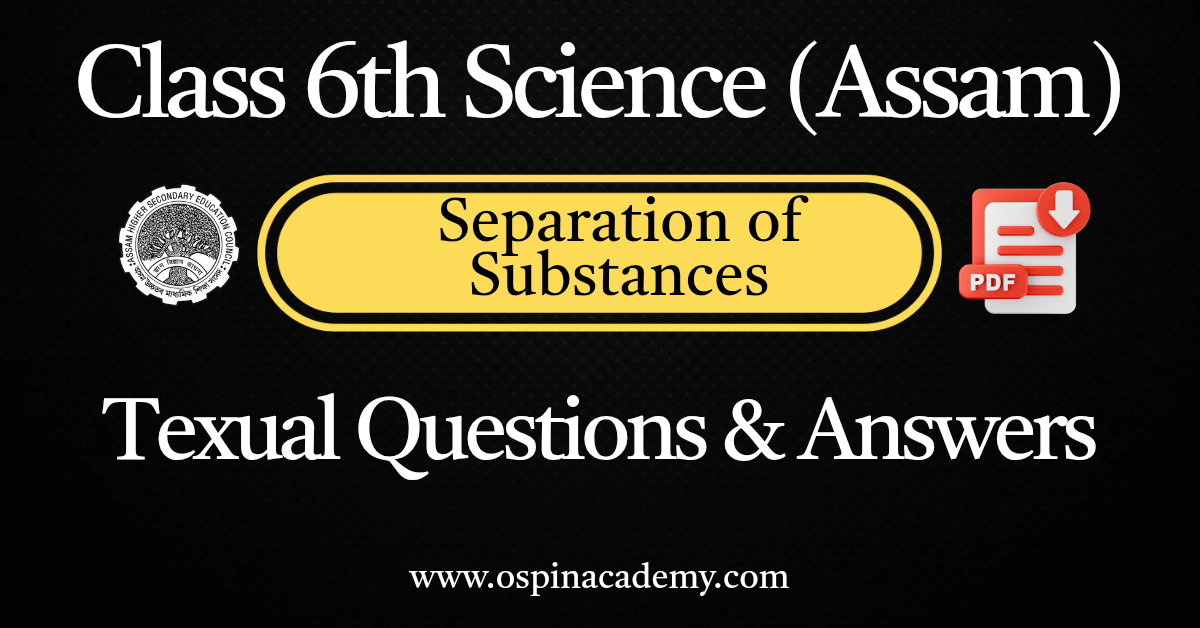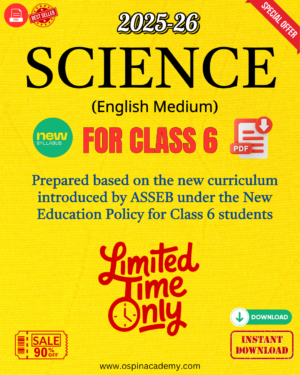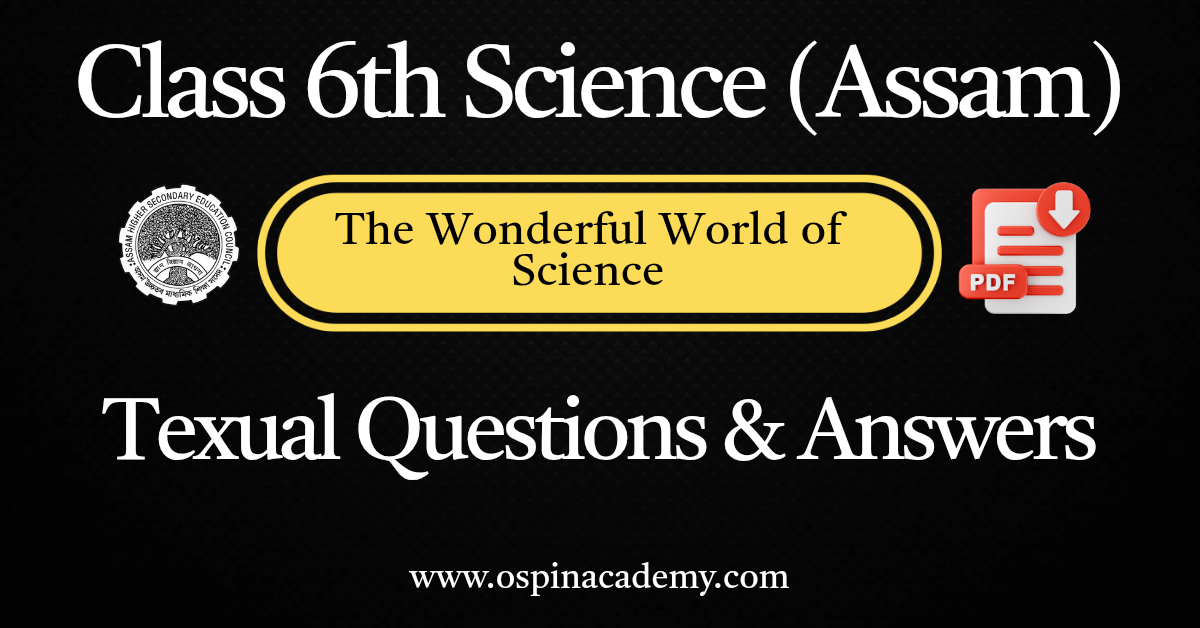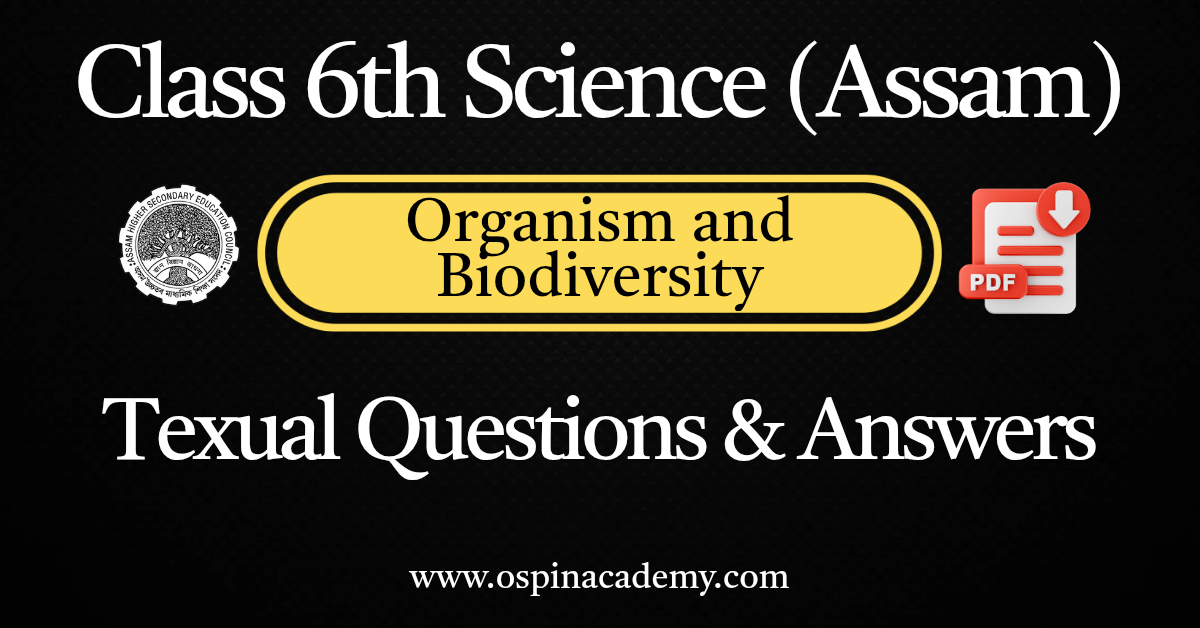Unlock the science of separating materials with Class 6 *Amar Bigyan* Chapter 6 – Separation of Substances, designed as per the new SCERT Assam syllabus 2025-26 for English Medium students. This chapter introduces students to the methods and techniques used to separate different substances from mixtures, highlighting their practical applications in daily life. Aligned with the updated Assam board curriculum, it encourages hands-on learning and scientific inquiry, making it an engaging exploration for young learners.
The new syllabus 2025-26 emphasizes practical knowledge and problem-solving skills, and this chapter provides a perfect platform to understand the principles behind separating substances. Students will explore techniques like filtration, evaporation, sedimentation, and more, learning how to apply them to real-world scenarios. From separating solids from liquids to purifying water, this chapter connects science to everyday activities. Scan the QR code A2V4T4 to access interactive resources and enhance your understanding of separation techniques as per the SCERT Assam English Medium curriculum.
✅ What You’ll Learn in Chapter 6:
- Introduction to mixtures and separation techniques in the new SCERT Assam syllabus
- Methods like handpicking, sieving, filtration, and evaporation
- Concepts of sedimentation, decantation, and distillation
- Differences between homogeneous and heterogeneous mixtures
- Practical applications of separation techniques in daily life
- Importance of separating substances for purification and recycling
- Simple experiments to demonstrate separation methods
- Inquiry-based activities to develop analytical skills, as per the 2025-26 curriculum
- Relevance of separation techniques in Assam’s local context
🎯 Why Choose Ospin Academy for Class 6 Amar Bigyan?
- 100% aligned with the SCERT Assam English Medium new syllabus 2025-26
- Clear, concise explanations, accurate Q&A, and exam-ready notes
- Ideal for Assam board students preparing for the updated curriculum
- Engaging video lessons available on Ospin Academy’s YouTube channel
- Downloadable resources, including chapter notes, MCQs, and QR code A2V4T4 content
- Focus on conceptual clarity and practical applications as per new syllabus guidelines
With the new SCERT Assam syllabus 2025-26, learning about separation of substances is both practical and exciting! Ospin Academy’s resources make Chapter 6 – Separation of Substances engaging, accessible, and easy to master. Use the QR code A2V4T4 to unlock additional study materials and join Ospin Academy to excel in the updated Class 6 Amar Bigyan curriculum while discovering the science behind everyday processes!
SCERT Assam Class 6 Science (Amar Bijnan) – English Medium Chapter-wise Solutions PDF
Special Combo Offer!
(For SCERT Assam Class 6, 2025)
Get complete chapter-wise Science (Amar Bijnan) solutions in English Medium prepared by expert teachers.
Covers all textbook exercises, key concepts, definitions, and diagrams as per the latest SCERT Assam syllabus.
Ideal for concept clarity, homework assistance, and exam preparation.

Class 6th Science
SEPARATION OF SUBSTANCES
Exercise
Q.1.Darken the circle of the correct answer:
(i) Which of the following mixtures can be separated by hand picking?
(a) Common salt and sand
(b) Sawdust and iron filings
(c) Rice grain and stone
(d) Camphor and sand
Answer:(d)
(ii) Which method is used when we wash pulses to clean?
(a) Threshing
(b) Handpicking
(c) Sieving
(d) Decantation
Answer:(d)
(iii) Which method is used for separating a mixture of iron and coal dust?
(a) Evaporation
(b) Threshing
(c) Magnetic separation
(d) Decantation
Answer:(c)
(iv) Which method is used to separate tea leaves from tea?
(a) Threshing
(b) Hand picking
(c) Sieving
(d) filtration
Answer:(d)
Q.2. Match the following:
|
(a) Separation of mud in water |
(i) Magnetic separation |
|
(b) Alum mixed in muddy water |
(ii) Winnowing |
|
(c) Rovolving a mixture at high speed |
(iii) Fillration followed by evaporation. |
|
(d) Groundnut oil and water |
(iv) Filtration |
|
(e) Sand and iron filings |
(v) Churning |
|
(f) Common salt dissolved in water |
(vi) Decantation |
|
(g) Husk from paddy seed |
(vii) Evaporation |
Answer:
|
(a) Separation of mud in water |
(iii) Fillration followed by evaporation. |
|
(b) Alum mixed in muddy water |
(iv) Filtration |
|
(c) Rovolving a mixture at high speed |
(v) Churning |
|
(d) Groundnut oil and water |
(vi) Magnetic separation |
|
(e) Sand and iron filings |
(ⅰ) Decantation |
|
(f) Common salt dissolved in water |
(vii) Evaporation |
|
(g) Husk from paddy seed |
(ii) Winnowing |
Q.3. Fill in the blanks
(a)_____ method is used to separate iron filing from heap of gar-bage
(b) Two immiscible liquids can be separated with the help gar______ of method.
(c) Flour and bran can be separated by ______method.
d) _________method is used to separate wheat from straw.
(e) During filtration of sand-water mixture, water particle are ____.pass though the holes of the filter paper because water particles are ______and sand particles are______
Answer:
(a) Magnetic separation
(b) Decantation
(c) Sieving
(d) Threshing
(e) fing, cannot be see with naked eye, large.
Q.4. Answer the following questions
(a) How will you separate a mixture of salt and sand?
Answer: (i) The mixture of salt and sand should be dissolved in water first. Salt will be dissolved in cuater and sand settled down on the bottom of the biker.
(ii) Through decantation or filtration sand can be separated from the mixture.
(iii) Now salt and water can be separated by evaporation.
(b) Suggest a method to separate a mixture of coconut
water.
Answer: Through decantation we can separate coconut oil from the mix-ture of coconut oil and water.
(c) How will you separate salt from salt solution?
Answer: Through evaporation we can separate salt from a salt solution.
Q.5. In the following mixtures which property can be used for the separation of their components
(a) Salt and chalk powder
Answer: Solubility in water Property is used to separate salt and chalk power. Because salt is dissolved in water but chalk powder is insoluble in waler.
(b) Rice and straw
Answer: Rice and straw both are solid but shapes are different they can be separated through threshing.
(c) Chalk and coal
Answer: The collour of chalk and coal are totally different, this property is used to separate chalk and coal. The process is hand picking.
(d) Iron filings and saw dust Answer: Iron is a magnetic substance, this magnetic property is used to separate iron filings from chalk dust. The method is magnetic separation.
(e) Sand and rice grain
Answer: Size of the substence is a property to separate sand and rice grain. Sieving method is used to separate rice from sand.
Q.6. How do we obtain salt from sea water?
Answer: sea water contains many other substances along with common salt. When sea water is allowed to stand in shallow pits, water slowly evaporates. After a few days the water evaporates com-pletely leaving behind the common salt mixed with some other substances. Common salt is then obtained from the mixtue through a process called purification.
Q.7. What is the criterion for selection of methods to separate the components from a mixture?
Answer: In order to separate substances present in mixture we need to know the characteristics of the components. A particlular char-acteristics of one of the components is used. These characteris-tics may be difference in size, shape, colour, weight, physical state, water soluble or not, attracted by magnet or not etc.
Q.8. Write all the possible methods used to purify muddy river water to obtain clear water
Answer: The following methods can be used to obtain muddy river water to clean water are
(i) Firstly the muddy water is allowed to settle down for sometime.
(ii) Then the clear water from the pot is separated through the process of decantation.
(iii) Lastly the decant water is filtered through filter paper to obrained clear water.
Q.9. Explain filtration with the help diagram. Activity 6.4 and it drawing may be placed against the
Answer: Do it Yourself.
10.Q. In the activity 6.2. in this chapter, name the method of separation aplicable for all the possible maxiures listed.
Answer:
|
Sl. No |
Two substances Taken |
Their physical state |
Soluble/Insoluble |
Method of separation |
|
1 |
Salt, water |
Solid, Liquid |
Soluble |
Evaporation |
|
2 |
Rice, pebble |
Solid, Solid |
Insoluble |
Hand picking |
|
3 |
Paddy, Rice |
Solid, Solid |
Insoluble |
Sieving |
|
4 |
Sand, Pebble |
Solid, Solid |
Insoluble |
Sieving |
|
5 |
Paddy, crop plant |
Solid, Solid |
Insoluble |
Threshing |
|
6 |
Seed, immatured seed |
Solid (heavy) Solid (light) |
Insoluble |
Winnowing |
|
7 |
Rice, water |
Solid, Liquid |
insoluble |
Decantation |
|
8 |
Soil, water |
Solid, Liquid |
insoluble |
decantation |
|
9 |
Oil, water |
Liquid, Liquid |
insoluble |
decantation/ |
|
10 |
tea leaves, water |
Solid, Liquid |
insoluble |
filtration |
|
11 |
Sand, water |
Solid, Liquid |
insoluble |
filtration |
|
12 |
Curd milk, lemon |
Solid, Liquid |
insoluble |
filtration |
|
13 |
Milk, water (fat, proken) |
Solid, Liquid |
insoluble |
Churning of milk of butter |
|
14 |
Sand, iron fittings |
Solid, Liquid |
insoluble |
magnetic separation |
|
15 |
Garbage, piece of iron |
Solid, Solid |
insoluble |
Magnetic separation |
|
16 |
Sugar, water |
Solid, Liquid |
soluble |
Evaporation |
Class 6 Amar Bigyan Chapter 6 – Separation of Substances FAQs
Get Free NCERT PDFs
If you want to download free PDFs of any chapter, click the link below and join our WhatsApp group:




